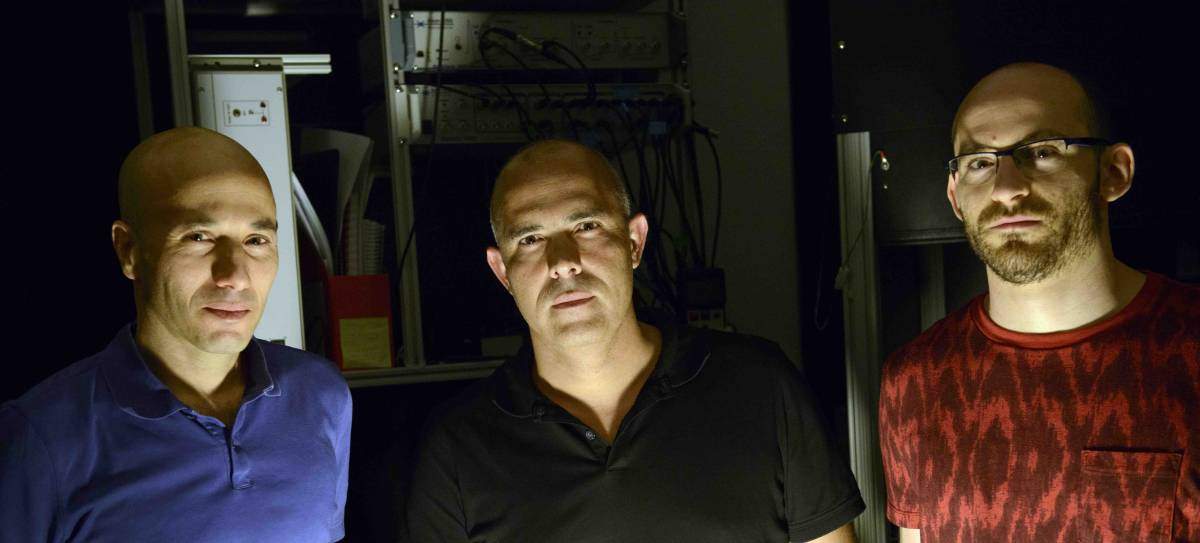A method for switching neurons on and off with light helps pinpoint anxiety neurons in the brain.
When we encounter stressful situations, the brain sets off a chain reaction – firing up everything from our pulse to our anxiety and fear levels. This is our body’s way of preparing to deal with that stressful situation – whether it is an enemy attack or a test in school. What controls the anxiety component of this response? New research at the Weizmann Institute of Science pinpoints nerve cells in a brain region called the extended amygdala, which regulates our fear and anxiety responses. Their findings were published in Molecular Psychiatry.
For most people, the fear and anxiety response quickly gets dialed down once the threat disappears. But in others, the anxiety remains and the condition may become chronic, leading to anxiety disorders, depression and post-traumatic stress disorder (PTSD). Drugs can help, but they are often only partially effective, at best.

(l-r) Dr. Ofer Yizhar, Prof. Alon Chen and Yoav Printz zeroed in on anxiety neurons
A few years ago some scientists had discovered a puzzling link: Mutations in the GBA1gene, which cause Gaucher’s disease, are also the most frequent genetic risk factor for Parkinson’s disease. On the face of it, Gaucher’s and Parkinson’s have nothing in common. In Gaucher’s, mutations in the GBA1 gene interfere with the breakdown of fatty molecules, causing them to accumulate in cells throughout the body and leading to an enlargement of the liver and spleen. Most patients have a mild form of Gaucher’s, but even in the more severe forms that affect the brain, the neurological symptoms are different from those of Parkinson’s, which causes tremors and changes in speech and gait.
The new study in Futerman’s lab, published in Cell Reports, might help explain the genetic connection between the two diseases. The study may also help predict the course of Gaucher’s and lead to a potential treatment for its most debilitating symptoms.
In the study, postdoctoral fellow Dr. Andrés D. Klein and other team members induced Gaucher’s disease in fifteen strains of mice. Survival rates varied enormously in the different strains: Some of the mice came down with a severe form of the disease and died soon, whereas others had a milder form and lived much longer. By performing a genetic analysis, the scientists identified nearly 20 genes that appeared to affect the severity of the disease. If these findings are confirmed in humans, analysis of the modifier genes may help predict the course of Gaucher’s and explain why it varies so widely in different people.
The study may also help explain why some people with the genetic features of Gaucher’s have no symptoms at all. Even though it takes two defective copies of the gene, one inherited from each parent, for the disease to develop, mutations in the GBA1 geneoccur relatively frequently in a few ethnic groups. In particular, about one in ten Ashkenazi Jews is a carrier of the faulty GBA1 gene, so one would expect Gaucher’s to be much more prevalent among this group than it actually is. “It’s possible that some people carry two defective copies of the GBA1, but the modifier genes we’ve discovered prevent the disease from manifesting itself,” says Futerman.
Tiny optic fibers could beam blue or yellow light onto these cells to switch their activities on or off
If these neurons regulate the anxiety response, it stands to reason they might also be involved in PTSD. To unravel the connection, the researchers first exposed the mice to a traumatic event. The mice were next transferred to a new environment and then given a reminder of the traumatic event. This can produce the symptoms of PTSD in mice as well as humans. Right after the reminder, some of the mice had the newly discovered nerve cells switched on through the optogenetic fibers. A week later, the mice were tested for PTSD. In the control group, in which the cells had been left alone, some 42% of the mice had developed the symptoms of PTSD. Only 8% of those that had received the optogenetic “turn-on” showed signs of the disorder.
“’Switching on’ these particular neurons improved the mice’s ability to recover from traumatic experience, and thus to cope with the symptoms of PTSD,” says Chen. “Locating the exact neurons and receptors involved could be crucial. The better we understand the brain’s mechanism for regulating the response to stress, the more it may help us to develop drugs that are more targeted, and hopefully more effective, for treating anxiety-related disorders.”
Prof. Alon Chen’s research is supported by the Henry Chanoch Krenter Institute for Biomedical Imaging and Genomics; the Perlman Family Foundation, Founded by Louis L. and Anita M. Perlman; the Irving Bieber, M.D. and Toby Bieber, M.D. Memorial Research Fund; the Adelis Foundation; the Appleton Family Trust; and Mr. and Mrs. Bruno Licht, Brazil. His research is also supported by the Ruhman Family Laboratory for Research in the Neurobiology of Stress.
This news appaered on Weizmann.ac.il

Recent Comments